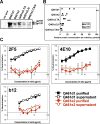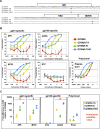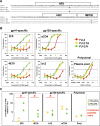Enhancing exposure of HIV-1 neutralization epitopes through mutations in gp41
- PMID: 18177204
- PMCID: PMC2174964
- DOI: 10.1371/journal.pmed.0050009
Enhancing exposure of HIV-1 neutralization epitopes through mutations in gp41
Abstract
Background: The generation of broadly neutralizing antibodies is a priority in the design of vaccines against HIV-1. Unfortunately, most antibodies to HIV-1 are narrow in their specificity, and a basic understanding of how to develop antibodies with broad neutralizing activity is needed. Designing methods to target antibodies to conserved HIV-1 epitopes may allow for the generation of broadly neutralizing antibodies and aid the global fight against AIDS by providing new approaches to block HIV-1 infection. Using a naturally occurring HIV-1 Envelope (Env) variant as a template, we sought to identify features of Env that would enhance exposure of conserved HIV-1 epitopes.
Methods and findings: Within a cohort study of high-risk women in Mombasa, Kenya, we previously identified a subtype A HIV-1 Env variant in one participant that was unusually sensitive to neutralization. Using site-directed mutagenesis, the unusual neutralization sensitivity of this variant was mapped to two amino acid mutations within conserved sites in the transmembrane subunit (gp41) of the HIV-1 Env protein. These two mutations, when introduced into a neutralization-resistant variant from the same participant, resulted in 3- to >360-fold enhanced neutralization by monoclonal antibodies specific for conserved regions of both gp41 and the Env surface subunit, gp120, >780-fold enhanced neutralization by soluble CD4, and >35-fold enhanced neutralization by the antibodies found within a pool of plasmas from unrelated individuals. Enhanced neutralization sensitivity was not explained by differences in Env infectivity, Env concentration, Env shedding, or apparent differences in fusion kinetics. Furthermore, introduction of these mutations into unrelated viral Env sequences, including those from both another subtype A variant and a subtype B variant, resulted in enhanced neutralization susceptibility to gp41- and gp120-specific antibodies, and to plasma antibodies. This enhanced neutralization sensitivity exceeded 1,000-fold in several cases.
Conclusions: Two amino acid mutations within gp41 were identified that expose multiple discontinuous neutralization epitopes on diverse HIV-1 Env proteins. These exposed epitopes were shielded on the unmodified viral Env proteins, and several of the exposed epitopes encompass desired target regions for protective antibodies. Env proteins containing these modifications could act as a scaffold for presentation of such conserved domains, and may aid in developing methods to target antibodies to such regions.
Conflict of interest statement
Figures





References
-
- Ferrantelli F, Rasmussen RA, Buckley KA, Li PL, Wang T, et al. Complete protection of neonatal rhesus macaques against oral exposure to pathogenic simian-human immunodeficiency virus by human anti-HIV monoclonal antibodies. J Infect Dis. 2004;189:2167–2173. - PubMed
-
- Mascola JR, Stiegler G, VanCott TC, Katinger H, Carpenter CB, et al. Protection of macaques against vaginal transmission of a pathogenic HIV-1/SIV chimeric virus by passive infusion of neutralizing antibodies. Nat Med. 2000;6:207–210. - PubMed
-
- Shibata R, Igarashi T, Haigwood N, Buckler-White A, Ogert R, et al. Neutralizing antibody directed against the HIV-1 envelope glycoprotein can completely block HIV-1/SIV chimeric virus infections of macaque monkeys. Nat Med. 1999;5:204–210. - PubMed
Publication types
MeSH terms
Substances
Associated data
- Actions
- Actions
- Actions
- Actions
Grants and funding
LinkOut - more resources
Full Text Sources
Other Literature Sources
Molecular Biology Databases
Research Materials

